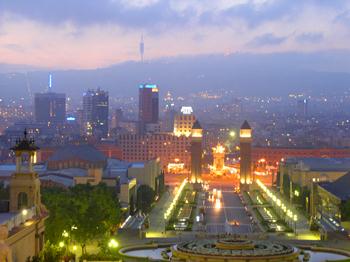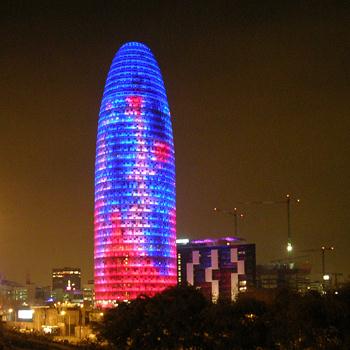
Nighttime in Plaça d'Espanya, the city's largest square.

Gay beachgoers at Barceloneta.
It’s a good thing Barcelona has great beaches to relax on, because this is a city that takes its time.
After all, construction of the Sagrada Família cathedral, designed by Antoni Gaudí, began in 1883. It isn’t expected to be finished until 2026, 100 years after its architect died. So don’t begrudge the afternoon siesta — Barcelona does not hurry. Nor will you if you brave the long lines to get a glimpse between the scaffolding inside the cathedral; it’s best seen from afar.
Nestled on the Mediterranean, surrounded by mountains, there is so much else to see in the rest of Barcelona. Since the 1992 Olympics, which reinvented the city through coastal and cultural projects, Barcelona has shone on the world stage.
Truly, it has something for everyone. Sun, ancient and modern architecture, a vibrant arts scene, museums, shopping, beaches, nightlife and, of course, soccer. You can do it all in Barcelona — as long as you don’t bank on getting much sleep. In fact, if you’re going from eastern North America, consider not changing your clocks. Everything is late: dinner is at 10pm, clubs don’t open until midnight and they’re empty until about 2am. They remain open until 6am, seven days a week.
Getting around is easier than in most European cities. For the most part, streets are laid out in a sensible grid. Walking is easy even on the very wide streets, while others built in the Dark Ages are basically narrow cracks.
There is a terrific bike rental system, like those now arriving in North America. With 400 locations to pick up from, a rental is only a credit card swipe away. There is also a good subway system.
La Rambla is the best-known street, taking you from Plaça de Catalunya in the heart of the city down to the sea. It is wide, pedestrian and tacky, with more Americans than small cities in the Midwest. Use it more to orient yourself than to hang around.
Just beside it is the Barri Gòtic, or gothic quarter, the heart of old Barcelona. Its buildings date to medieval times, and the relative lack of cars only adds to the charm. Old building buffs beware, though: there are so many churches and plazas buried within, it’s easy to lose track of time — and yourself, since it’s quite a maze.
Finding the newly renovated Picasso Museum can be tricky. It’s worth getting a little lost, however, if only to stumble across the Museu de la Xocolata, just around the corner. Chocolate has been a staple of Barcelona’s cuisine for centuries. The samples will give you energy for wandering through the parks and gardens district to check out the Arc de Triomf, built for the 1888 World’s Fair.
Be sure to take the funicular railway up Montjuïc to enjoy sweeping views of the city and sea. While you’re there, take in the magic fountain that blows to classical music. Plus, there are oodles of museums and art galleries, including the Catalan Art Museum. For architecture buffs, there is a mock village that highlights various building styles in the area and is a main tourist draw.
Other touristy must-sees include Parque Güell, designed by Gaudí, which gives a sometimes-psychedelic view of the city beneath. But Gaudí is pretty much everywhere, along with newer, quirky buildings that are excellent examples of contemporary architecture.
Then there’s the gaybourhood.
The Gaixample, in the Eixample district, is sandwiched between the old city and more modern suburbs. It is a relaxed mix of cafés and shops during the day. By night — any night — the Matinée Group will have something for you to do. Its storefront location lets you know what’s on before you head out.
The party scene’s highlight is the Circuit Festival in early August, with a shorter Girlie Circuit for women the same week. Other big events are Bearcelona in April, Pride in June and the gay and lesbian film festival in October.
Shopping is cheaper than the European norm. Check out the side streets off Passeig de Gràcia for shoes, styles and sweaters to fit most budgets and tastes.
Dining is as good as you’d expect. Eixample is spoiled for choice, and even focusing on Catalan food or tapas will leave many great places untouched. A good bet is Manairó on Diputació St, with Catalan faves like salted cod and pork sausages. There are great places for a drink around the corner on Muntaner St.
Further afield, the waterfront and Barri Gòtic also have plenty to keep your taste buds happy. You’re not going to go hungry, though you might need to keep your bike rental for an extra hour to work things off.
If you’re looking for places to stay, you can’t go wrong with the gay Axel Hotel, in the heart of Eixample. Part of a chain that has outlets in Berlin and Buenos Aires, Barcelona’s is in a gorgeous 19th-century building with all the mod-cons: gym, sauna and roof-top hot tub. A bustling martini bar is great for predrinking.
More upscale is Europe’s premier W hotel, located on the water. Even if you don’t stay there, its bar overlooks the Mediterranean and the pool scene on a summer afternoon can’t be beat.
Lastly, a word on the airport: for five euros, the Aerobus gets you downtown and is your best bet. But plan ahead before taking it back. There’s no list of which airlines use which terminals, which are kilometres apart, so make sure you know before getting on board.
Bon viatage — have a good trip.
Getting there
Air Canada, Lufthansa and Spanair offer direct and connecting flights from Toronto to Barcelona; seven other airlines offer connecting flights with one and two stops. Barcelona Airport has EMT Aerobus transport from Terminals 1 and 2 going directly to Plaça d’Espanya or Plaça de Catalunya for five euros. There are also RENFE trains every half hour from Terminal 2, with access by shuttle bus from Terminal 1. Trains go to Barcelona Sants Station and cost three euros. From there you can transfer to trains for Sitges, hail a taxi behind the station or connect to the TMB Metro system. Trains and modern intercity buses connect with all European cities. Barcelona receives cruise ships from the Americas at its port and has cruise connections to points all around the Mediterranean, even to Scandinavia.
Barcelona Airport
barcelona-airport.com
EMT Aerobus
emt-amb.com
RENFE Trains
renfe.com/en/viajeros/
TMB Metro System
tmb.cat
Getting around
The Gaixample (in Eixample district) is quite compact, so you can easily walk to any of the bars, sex clubs, dance clubs, shops, restaurants and bathhouses there. Plaça de Catalunya, La Rambla, Barri Gòtic and sights like the Gaudí Casa Batlló or the Picasso Museum are an easy stroll. The Metro will get you most anywhere else. Single-fare tickets are 1.40 euros, or buy a discount card for one to five days’ use. Use ticket machines if the booth is closed. If going to Platja de la Mar Bella, take the L4 line to Poble Nou Station and grab a taxi, take bus number 41 or hike 30 minutes to the water.
Big gay events
CIRCUIT FESTIVAL
Aug 4–14, 2011. Europe’s biggest gay culture and leisure festival: 10 days of sun, entertainment and parties in water parks and on the beach. The Girlie Circuit takes place Aug 9–15.
›circuitfestival.net
FEAST OF LA MERCÈ
Each year in the last week of September, Barcelona holds its largest festival. Events include Correfoc, a “fire run” through cascades of fireworks; the human towers in Plaça de Sant Jaume; music concerts; and the Parade of Giants.
›bcn.cat/merce
FILMOTECA DE CATALUNYA
Taking place in mid-October, the 11th annual Barcelona Gay and Lesbian Film Festival has everything from gay feature films to shorts to porn screenings.
›barcelonafilmfestival.org
Walking adventures
MERCAT DE LA BOQUERIA
One of the best markets in Europe, Boqueria Market on La Rambla (89 La Rambla) is the oldest and most comprehensive food market in Barcelona. Fruit, vegetables, meat, fish, cheese, nuts and thousands of other products can be found in open stalls beneath an ornate metal-and-glass roof. Sample a chocolate truffle here, a fruit smoothie there, or stock up with provisions for a picnic in nearby Plaça de Catalunya. Open Monday to Saturday,
8am to 8:30pm.
PORT VELL
The old harbour, stretching from Columbus Monument at the end of La Rambla to the Barceloneta, has an Imax cinema, the Aquarium, the Maremàgnum shops and performance spaces, among other attractions. At the 14th-century medieval shipyards (the Drassanes Reials), is Barcelona’s Maritime Museum, and at the waterfront you’ll find the 1918 schooner, the Pailebot Santa Eulàlia, named for Barcelona’s co-patron saint. This is also the departure point for the Golondrinas — the pleasure boats that ply the waters of Port Vell. The Columbus Monument, dating from the Universal Exhibition of 1888, has a gallery with views of the sea and La Rambla from heights of 60 metres.
Plan a few days in Sitges
The coastal village of Sitges is a beach getaway for residents of nearby Barcelona and a favourite vacation spot for gay people from all across Europe. With at least three dozen gay restaurants and clubs, scores of shops and plenty of gay beaches, it’s no wonder that gay people flock to its cobblestone streets. While you can get by with English or Spanish, you’ll hear many other languages in this cosmopolitan community. French is very common, as is Catalan, the local language in which most street signs are written. The offerings in the restaurants are equally diverse, with dishes from around the world.
Gays are an important part of the local culture, so there are few tensions. Same-sex couples can hold hands while walking on the beach or between the numerous cafés in the streets and never get a second glance. Gay nightlife thrives, but it often remains discreetly at home in that Mediterranean way, behind closed doors. Men and women of any sexual orientation can show public affection for one another here, even as news reports say that effeminate boys are sometimes harassed in school. Blatantly sexual gay parades raise few eyebrows, and cops don’t go out of their way looking for men having sex in woods, on beaches or in the back rooms of bars. It’s another world, to be sure.
Barcelona International is the closest airport. RENFE trains or shuttle buses take you to Barcelona Sants Station, where a local train will get you to Sitges in approximately 20 minutes for about $5. Driving here can be more trouble than it’s worth, as parking in Sitges is expensive and sometimes hard to find. Walking is the best way to get around and many streets in the centre are closed to traffic. Taxis around town cost no more than $15.
On the web:
Barcelona Aquarium
aquariumbcn.com
Golondrinas
lasgolondrinas.com
Maritime Museum
mmb.cat
Maremàgnum
maremagnum.es
Picasso Museum
museupicasso.bcn.es/en

 Why you can trust Xtra
Why you can trust Xtra